|
|
|
| Adding
and Calculating - Adding machines were around
for a long time in the days before electronic calculators.
Adding up in the old UK currency of pounds, shillings
and pence required special adaptations. Of course
you could use a ready reckoner and look the answer
up in the tables or there was always pencil and
paper. Images on this pages are not to the same
scale. |
 |
 |
 |
| In The Hand |
 |
 |
 |
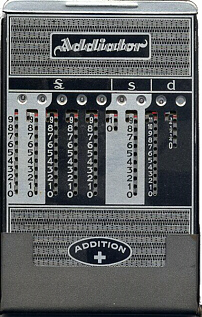 |
 |
Addiator-
A calculator for the old (pre 1971) pounds,
shillings and pence currency. To add, the
stylus is inserted in the hole to the right
of the desired number. If the number is silver,
the stylus is pulled down to the bottom of
the column. If red, it is pushed up to the
top and then pulled round to the left and
down in order to carry to the next column.
To subtract, the Addiator is flipped over.
The current total is also shown on the other
side. The same operation is carried out but
this time the total is reduced by the amount
entered. Adding and subtracting can be carried
out continually provided the total does not
exceed £99,999 19s 11¾d. The
total can be cleared by pulling up on the
handle at the top (viewed from the adding
side. From the subtracting side, it is at
the bottom). The stylus has a handy pencil
at the other end. The case can be positioned
to act as a desk stand or the Addiator can
be removed from the holder for easier handling.
Addiator Gesellschaft Berlin (marked Foreign). |
|
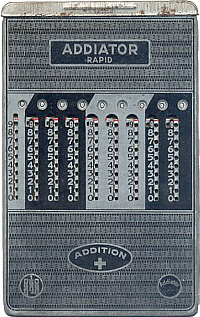 |
|
Addiator-
This is a decimal version. This one does not
open up and does not stand up on the desk.
The stylus has no pencil. |
|
 |
 |
 |
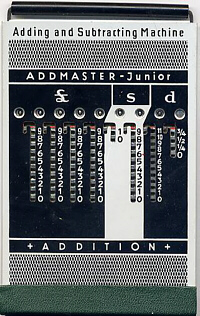 |
 |
Addmaster
- A pocket calculator operated by sliding
bands up and down with a stylus. Adding is
performed on one side and subtraction on the
other, flipping between the two as needed.
If the number is silver, the band is slid
down to the bottom. If red, it is slid up
to the top and round to the left and down
to carry over to the next column to the left.
The stylus has a propelling pencil on the
other end and the holder includes a notepad.
The similarity to the larger Addiator is no
coincidence. The designer of the Addmaster
was the son of the founder of Addiator. The
Addmaster company was also known as Admult.
Addmaster West Germany. |
|
|
 |
 |
 |
 |
 |
Arithma
- A pocket calculator for sterling currency.
The stylus, carried clipped to the side of
the Arithma Junior, is used to slide the bands
up or down as required. The top set of numbers
is used for addition. If the number is white
it is pulled down to the bottom. If red it
is pulled up to the top, round to the left
and down to carry to the next column. The
bottom set is for subtraction. This time,
if the number is white it is pushed up to
the top and if it is red down to the bottom,
round and up to the left to carry. That means
that in either addition or subtraction, white
is to the middle and red is away from the
middle. The result is shown in the central
display. The arithma has a soft carrying case.
Addiator W.Germany (marked Foreign). |
|
 |
|
Arithma
- A pocket calculator for decimal calculations. |
|
 |
 |
 |
 |
 |
Decimeter
- A pocket calculator to convert between the
old sterling money (£sd) and the new
decimal currency (pounds and pence). The result
is rounded to the nearest half new penny.
By turning the shillings and pence dials to
the required amount, it gives the result in
(rounded) new pence in tens and units. The
example here shows 17 shillings and six pence
as 85 + 2½ which is 87½ pence.
A lot of similar converters were around for
a short time in 1971 when the UK changed currencies.
They were useful for people who wanted to
compare shop prices. The Decimal Currency
Board also issued a printed "Shoppers'
table". It had been expected that there
would be a long period where both sets of
prices would be displayed, but in fact the
changeover was quite quick. |
|
|
 |
 |
 |
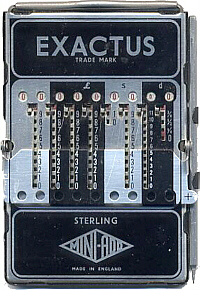 |
 |
Exactus
- A small, pocket sized calculator. Like the
Addiator, a stylus is used to move the numbers
up or down. However, to change between addition
and subtraction a hinged plate is raised or
lowered rather than turning the Exactus over.
To add, the number is pulled down to the bottom
if it is silver or up, round to the left and
down if it is red. To subtract, the number
is pulled to the top if red or down, then
round to the left and up if silver. The small
size and the hinged flap make the Exactus
fiddly. I find it easy to make a mistake on
the Exactus while the Addiators are much more
usable. Sterling Mini-Add England. |
|
|
 |
 |
 |
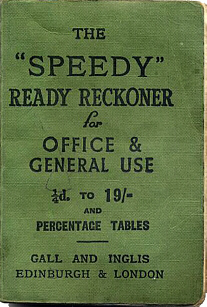 |
|
Ready
Reckoner - Of course you could use
a Ready Reckoner like mine and look the answer
up in the tables. The "SPEEDY" Ready
Reckoner for Office & General Use - ¼d
to 19/- and Percentage Tables - ¼ds
to 1/- - ½ds to 2/- - 1ds to 5/- -
6ds to 12/6 - 1/-s to £1 - Gall and
Inglis, 12 Newington Road, Edinburgh 9 and
London. |
|
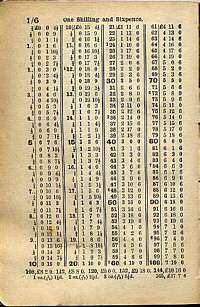 |
|
|
 |
 |
 |
| On The Desk |
 |
 |
 |
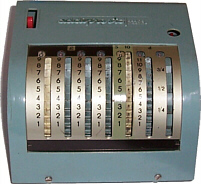 |
 |
Addipresto
- A neat desk-top adding machine. A stylus
is used to pull down on the bands. The band
is pulled right to the bottom causing the
total in the window above to change. Only
adding is possible. The red lever on the left
clears the display to zero. The stylus would
have been placed in the hole on top when not
in use. Mine is missing and marks on the number
bands suggest a pen was used. This would have
been better for the operator who would need
to write down the results. Care must be taken
as it is possible to pull the bands too far
and cause a 9 to be added as 10. Brevetti
Lanza-Savona Italy. |
|
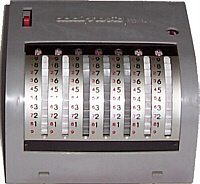 |
|
Addipresto
- This is a decimal version and is complete
with box, cover, stylus and instructions.
Subtraction is possible using a number's complement.
The advert and the instructions show this
model was ready for use with decimal money
introduced in 1971. The complement of a number
(on this machine) is the difference between
that number and 9. Using this system, the
complement is added to the value in each column,
including any column with a zero. However,
to finish the calculation, a 1 has to be added
to the result. This could have been avoided
if the right-hand column had been marked with
complements of 10 instead of 9, with zero
treated as 10. |
|
 |
 |
 |
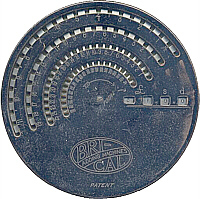 |
 |
Bri
Cal - Patented by H. and M. Dickinson
and manufactured between the beginning of
the twentieth century and the Great War by
The British Calculators Ltd.. The lettering
reads Bri-Cal Adding Machines. The disc is
operated by inserting a stylus in the appropriate
slot and moving clockwise. Addition is immediate
so the amount can be entered in any order.
The result is displayed in four small windows.
The pence selector is in halfpenny steps.
To clear the total to zero, the stylus is
inserted in the red slot of the outermost
ring and pulled as far as it will go, again
clockwise. This is repeated for each ring
in turn, moving towards the centre. Originally
there would have been a pair of styli but
these have been lost. The Bri-Cal, which has
a felt pad on the back, should be placed on
a desk and held with the left hand while the
stylus is worked with the right. The machine
is not suitable for holding in the hand. The
circular design makes operation easy for right
handed people but it is difficult if you are
left handed. At the start of the twentieth
century being left handed was considered abnormal.
There is a felt-lined wooden box with the
Bri-Cal. This is currently awaiting repair.
British Calculators Ltd England. |
|
|
 |
 |
 |
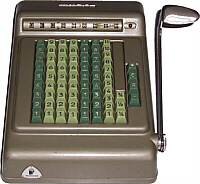
|
 |
Brunsviga
- A machine which can add and subtract in
pounds, shillings and pence. The desired buttons
are pressed, including the minus key if needed,
and then the lever. Errors are cleared by
pressing the C key before pressing the lever.
Multiplication is also possible by using the
repeat button (R). Includes halfpennies and
farthings. The maximum amount that can be
entered is £9,999 19s 11¾d while
the maximum total is £99,999 19s 11¾d.
The total is cleared by pressing the star
button and then the lever. If the last calculation
was a subtraction, the lever must be pressed
before as well as after the star button. A
label on the back reads BRUNSVIGA-ADSUM Sole
Concessionairs for U.K. and Eire W.H.Turnbull
& Co. Ltd. 14, Philpot Lane - LONDON E.C.3
Made in Western Germany. This version of the
Adsum was introduced in 1956 and would have
been in use until decimalisation in February
1971. |
|
|
 |
 |
 |
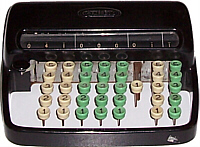 |
 |
Contex
A - Made of bakelite, the model A has
a half keyboard. This example is for sterling
£sd but does not have fractions (halfpennies
and farthings). The half keyboard design allows
experienced users to operate the machine very
quickly, pressing two keys where necessary.
The base of the carrying case can be left
under the machine to give a more stable operating
environment. The model A was introduced in
1946 and manufactured until 1960. Carlsen
Brothers Gentoft, Denmark. |
|
|
 |
 |
 |
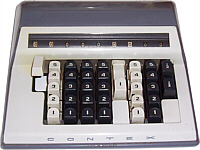 |
 |
Contex
B - A more modern appearance than the
model A, looking like a calculator but still
mechanical and still only able to add. The
internal workings are similar to the earlier
model A. The half keyboard design allows experienced
users to operate the machine very quickly,
pressing two keys where necessary. Designed
for £sd sterling and including farthing
and halfpenny keys, this model was introduced
in 1960. Carlsen Brothers Gentoft, Denmark |
|
|
 |
 |
 |
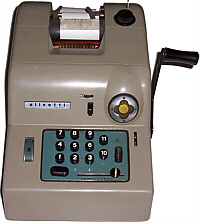 |
 |
Olivetti
15 £sd - A version equipped with
additional 10 and 11 keys for sterling £sd
currency, but no halfpenny key. A joystick
selects subtraction, sub-total, total or number
not to be included. The amount is entered,
the joystick set if required and the handle
pulled forward and released. The amount is
printed on a paper roll, in black for individual
amounts and in red for the total or sub-total,
using a typewriter ribbon. Pressing either
the 10 or 11 key locks the keyboard to ensure
that these values are registered only as pence.
Care must be taken to enter a zero in front
of single digit shillings amounts after pounds
have been entered by pressing the large black
key (twice if no shillings). Any amount of
shillings higher than 19 will be reduced to
below 20, for instance 33 will register as
13. The striped knob at the bottom right moves
one notch to the left for each digit entered.
Pulling this to the far right clears all numbers
entered. There is a sliding control above
this which allows multiplication. This is
achieved by entering an amount, setting the
control to multiplication and pulling the
handle the required number of times. There
is a counter on the left of the keyboard so
that the operator can see how many times the
amount has been multiplied. There is a slider
to the left of the joystick to disable the
entry of shillings and pence, calculations
then being in whole numbers. At the top right
is a rotating manual paper feed control. The
original design dates from 1949 but the machine
was probably made around 1960. |
|
|
 |
 |
 |
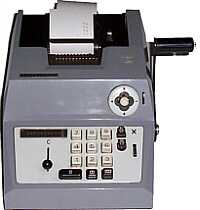 |
 |
Olivetti
20 £sd - A version equipped with
additional 10 and 11 keys for sterling £sd
currency or ½ for decimal money. A
lever on the underside allows switching between
£sd and decimal currencies. The ½
keys are only available in decimal mode. A
joystick selects subtraction, sub-total, total
or number not to be included. The amount is
entered, the joystick set if required and
the handle pulled forward and released. The
amount is printed on a paper roll, in black
for individual amounts and in red for the
total or sub-total, using a typewriter ribbon.
Care must be taken to enter a zero in front
of single digit shillings amounts. The original
design dates from 1949 but the machine was
made around 1960. It seems that these machines
were designed for the Australian and New Zealand
markets. These countries withdrew the old
halfpenny earlier than the UK and also made
the change to decimal money before us. This
would explain the lack of a ½ key in
£sd mode. Olivetti Summa Prima 20 Italy. |
|
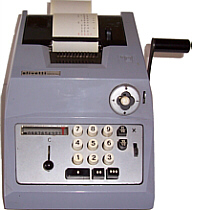 |
|
Olivetti
20 £sd - This one has the older
style round keys. |
|
 |
 |
 |
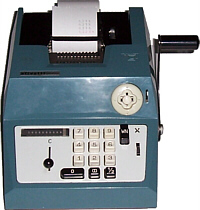 |
 |
Olivetti
Decimal - A version for decimal currency
(introduced in Australia and New Zealand in
1966 and in the UK in 1971) .There is a key
for half cents or half pennies. A joystick
selects subtraction, sub-total, total or number
not to be included. The amount is entered,
the joystick set if required and the handle
pulled forward and released. The amount is
printed on a paper roll, in black for individual
amounts and in red for the total or sub-total,
using a typewriter ribbon. The machine was
designed in 1949 and manufactured in the 1960s
A small leaflet contains user instructions
and examples. Olivetti Summa Prima 20 Italy. |
|
|
 |
 |
 |
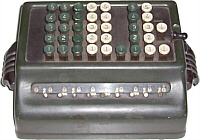 |
 |
Plus
- This adding machine probably dates from
the 1950s although the design is some twenty
years older. It is adapted for the old UK
sterling currency of pounds, shillings and
pence. Each column of keys has the numbers
1 to 5. Starting from the left, there are
three columns of green keys and two of white
ones for pounds, green keys for shillings
(including a separate one for ten shillings)
and white ones for pennies, halfpennies and
farthings. The lack of numbers greater than
five means that an experienced operator can
work very quickly without looking at the keys,
a bit like touch typing. To key in a higher
number, the operator presses two keys. If
two keys in the same column are pressed at
the same time, only the lower one registers.
But if two keys in different columns are pressed
together, both register. The keys on the odd
number rows are more deeply recessed than
those on the even rows. The small levers on
the display can be moved up or cleared down
to make the numbers easier to read. The result
shown here is £6,113 12s 3¾d
and the maximum is £999,999 19s 11¾d.
The lever next to the ½ key is used
to clear the result display to zero. This
machine can only be used to add but larger
versions with the full range of numbers could
also subtract while multiplication and division
were possible with practice. |
|
|
 |
 |
 |
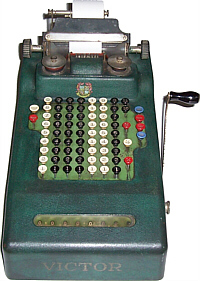 |
 |
Victor
- A manual machine for sterling currency.
Has four columns of keys for pounds (the thousands
column in white and the rest black), two for
shillings (white), one for pence (black) plus
one with 11d, 10d, ¾d, ½d and
¼d keys. On the left are additional
keys marked Error (top white) and Repeat (bottom
red) and on the right are keys for Sub-Total
(top blue) Total (top red), Subtract (lower
red) and Non-add (bottom blue). Subtraction
works provided the result is positive, but
a negative result is shown as the complement,
not the actual value. The total and sub-total
can be printed in red if a two-colour ribbon
is fitted. The fitted metal spools operate
in both directions to get the best use out
of the ribbon. Below the keyboard is a mechanical
display showing the current total. Victor
Adding Machine Company Chicago, USA |
|
|
 |
 |
| |
|